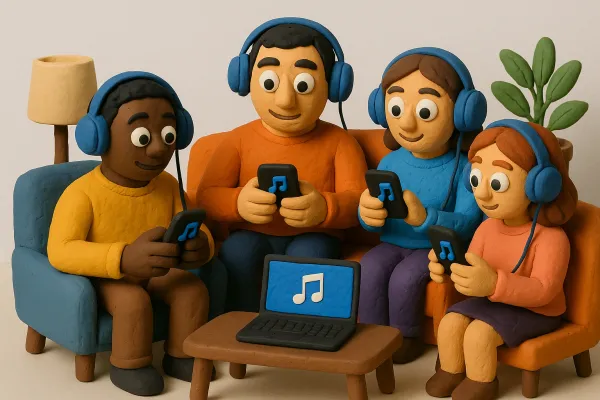Is There a Limit on Spotify Playlists? Discover the Truth in 2025!

As we step into 2025, many Spotify users are left wondering: is there a limit on Spotify playlists? With the growing popularity of playlists on the platform, understanding any restrictions becomes essential for avid music lovers and creators alike. In this article, we'll explore the details surrounding playlist limits, user opinions, and tips for creating the perfect playlist, all while keeping you informed about Spotify's evolving features.
Key Takeaways
- Spotify has specific limits on the number of playlists a user can create, which is important for organization.
- User opinions are mixed on whether playlist limits are helpful or restrictive, with some advocating for more flexibility.
- Spotify's playlist features continue to evolve, providing better tools for users to curate their music.
- Comparing Spotify to other streaming platforms reveals different approaches to playlist limits and features.
- The impact of playlist limits on artists can shape how their music is discovered and promoted.
Understanding Spotify Playlist Limits
What Are Playlist Limits?
Okay, so let's talk about playlist limits on Spotify. What exactly are they? Well, it boils down to the restrictions Spotify places on your account regarding playlists. This could mean a limit on the number of playlists you can create, the number of songs you can add to a single playlist, or even the number of songs you can have saved in your Liked Songs playlist. It's important to know these limits so you don't run into any frustrating roadblocks while curating your perfect listening experience.
Why Do Limits Exist?
Why does Spotify even bother with playlist limits? It might seem annoying, but there are a few reasons. First, it helps with platform stability. Imagine millions of users creating massive playlists with thousands upon thousands of songs. That's a lot of data to manage! Limits help keep things running smoothly for everyone. Second, it can help prevent abuse of the system, like bot accounts creating tons of playlists to artificially inflate stream counts. Finally, some believe it encourages users to be more selective and thoughtful about their music choices.
How Many Playlists Can You Create?
So, how many playlists can you actually create on Spotify? As of March 2025, Spotify hasn't officially announced a hard limit on the number of playlists a user can create. However, there is a limit to the number of songs you can save. Currently, you can save up to 10,000 songs to your "Liked Songs" playlist. While there isn't a specific number for total playlists, it's good to keep in mind that excessive playlist creation could potentially impact your account's performance.
It's always a good idea to periodically review your playlists and remove any that you no longer listen to. This not only helps keep your Spotify organized but also ensures that you're making the most of your available storage and processing power within the app.
The Great Playlist Debate
User Opinions on Playlist Limits
Okay, let's talk about what people really think about these playlist limits. It's a hot topic, trust us. Some users are totally chill, saying they rarely even hit the limit. They're all about quality over quantity, curating their playlists carefully. But then you've got the other side – the music hoarders (no judgment, we might be among them). They want all the songs, all the time. For them, a limit feels like a personal attack. We've seen some pretty passionate debates online about whether Spotify should raise or remove the limit altogether. It really boils down to how people use the platform, and everyone's different, right?
Are Limits Beneficial?
This is where it gets interesting. Are playlist limits actually a good thing? Some argue that they force us to be more selective, leading to better, more focused playlists. Think about it: if you can only have so many songs, you're going to pick the best ones, right? This could lead to a better listening experience overall. Plus, it might help with music discovery. On the other hand, limits can feel restrictive, especially if you're trying to create a comprehensive collection of a particular genre or artist. It's a tough call, and there's no easy answer.
Comparing Spotify to Other Platforms
It's worth looking at how Spotify's playlist limits stack up against other music streaming services. Some platforms have higher limits, while others have none at all. This can be a major factor for users when choosing a service. For example:
- Platform A: Unlimited playlists, 50,000 songs per playlist
- Platform B: 1,000 playlists, 10,000 songs per playlist
- Platform C: 500 playlists, 5,000 songs per playlist
Ultimately, the best platform depends on your individual needs and preferences. If you're a casual listener, Spotify's limits might not even be an issue. But if you're a serious music collector, you might want to explore other options. It's all about finding what works best for you.
Creating the Ultimate Playlist
Tips for Curating Playlists
Okay, let's talk about making playlists that don't just hold songs, but actually mean something. We've all been there, throwing random tracks together and calling it a day. But a truly great playlist? That takes a little effort. First, think about the vibe. Is it for chilling, working out, or a specific mood? This helps narrow down your choices. Then, consider the flow. How do the songs transition from one to another? A smooth transition can make all the difference. Don't be afraid to experiment with genres, but make sure there's a common thread. And most importantly, listen to your gut! If a song doesn't feel right, ditch it. It's your playlist, after all. You can add to playlist at any time, so don't be afraid to experiment.
- Define the playlist's purpose.
- Prioritize song flow and transitions.
- Trust your instincts when selecting tracks.
How to Organize Your Music
Organization is key to a killer playlist. We like to start by sorting our music library into broad categories like genre, mood, or era. From there, we create subcategories to get even more specific. For example, under "Rock," we might have "Classic Rock," "Indie Rock," and "Hard Rock." This makes it way easier to find the perfect song when you're in the playlist-building zone. Another tip? Use tags or labels to add extra info to your tracks. This could be anything from the song's energy level to its suitability for a specific activity. Trust us, a little organization goes a long way.
Using Playlist Features Effectively
Spotify has a bunch of cool features that can take your playlists to the next level. Collaborative playlists are awesome for sharing music with friends, and the 'Enhance' feature can suggest new tracks based on your existing playlist. We also love using the playlist description to set the tone and give listeners a sense of what to expect. And don't forget about the playlist cover! A visually appealing cover can make your playlist stand out and attract more listeners. Experiment with different features and find what works best for you. Here's a quick rundown:
- Collaborative Playlists: Great for sharing with friends.
- Enhance Feature: Discover new music based on your playlist.
- Playlist Description: Set the tone and attract listeners.
Playlists are more than just a collection of songs; they're a reflection of your taste and personality. Take the time to curate them with care, and you'll end up with something truly special.
Spotify's Evolving Features
Recent Updates in 2025
Okay, so it's 2025, and Spotify's still kicking. We've seen some interesting changes this year. One of the biggest is the push for even more personalized experiences. Spotify seems to be really focusing on AI-driven curation. They're trying to predict what we want to hear before we even know it ourselves. It's kind of cool, but also a little creepy, right?
- Improved audio quality options (finally!).
- More interactive podcast features.
- A revamped user interface (again!).
I've noticed that the algorithm is getting scarily good at suggesting new artists I actually like. It's like they're reading my mind. I'm not sure if I should be impressed or concerned.
Future Predictions for Spotify
Where's Spotify headed? Well, we think they're going to double down on the social aspect. Imagine more ways to connect with friends through music, maybe even integrated virtual concerts. And who knows, maybe they'll finally let us import local files easily across all devices. That would be a game-changer. Here's what we're betting on:
- Deeper integration with social media platforms.
- Expansion into live music experiences.
- More sophisticated AI-powered music discovery.
User Feedback on New Features
So, what do people think about all these changes? It's a mixed bag, honestly. Some folks are loving the new features, especially the improved sound quality. Others are complaining about the constant UI tweaks. It seems like every update brings a new wave of confusion. But hey, at least they're trying, right? User feedback is super important, and it seems like Spotify is trying to listen. They've even started doing more public beta tests before rolling out major updates. Check out the Spotify support page to see what others are saying.
Exploring Playlist Alternatives
Spotify's playlist limits can sometimes feel restrictive, but don't worry, there are plenty of other ways to discover and share music. We're going to explore some cool alternatives that can help you break free from those constraints and expand your musical horizons. Let's jump in!
Third-Party Playlist Creators
Did you know there's a whole world of playlist creators outside of Spotify itself? These platforms often offer unique features and ways to discover music that you might not find on Spotify. Some focus on specific genres, while others let you create playlists based on mood or activity. These third-party apps can be a great way to find hidden gems and connect with other music lovers.
- Some apps analyze your listening habits across multiple platforms to create personalized playlists.
- Others focus on social sharing, allowing you to collaborate with friends on playlists.
- Many offer advanced filtering options, so you can find exactly the type of music you're looking for.
Collaborative Playlists
One of the best ways to overcome playlist limits is to team up with friends and create collaborative playlists. This way, everyone can contribute their favorite songs, and you can discover new music from each other. It's like having a never-ending stream of fresh tunes, all curated by people you trust. Plus, it's a fun way to stay connected and share your musical tastes. You can even find Spotify playlist exchange groups online to broaden your horizons.
Sharing Playlists with Friends
Sharing playlists is another fantastic way to get around those pesky limits. Instead of trying to cram everything into your own playlists, why not share your favorite finds with your friends? You can send them links to playlists you enjoy, or even create playlists specifically for them based on their tastes. It's a great way to spread the musical love and discover new artists at the same time. Plus, who knows, they might share some awesome playlists with you in return!
Sharing music is caring, and it's also a great way to discover new artists and genres. Don't be afraid to step outside your comfort zone and explore what your friends are listening to. You might be surprised at what you find.
The Impact of Playlist Limits on Artists
How Limits Affect Music Discovery
Okay, so playlist limits on Spotify might not seem like a huge deal to the average listener, but for artists, it can really change things. Think about it: the more playlists out there, the more chances for their music to be heard. If curators are forced to be super selective because of a limit, it could mean that some great, up-and-coming artists get overlooked. It's like a funnel – the narrower the funnel, the fewer artists make it through. This is especially true for smaller, independent artists who rely on playlist inclusion to get their music out there. It's a tough landscape out there, and every little bit counts. The top streamed artists are usually already well-known, so it's the smaller artists who feel the pinch.
Artist Strategies for Playlist Inclusion
So, what can artists do to get their music on playlists, especially with these limits? Well, it's all about being smart and strategic. Here are a few things we've seen work:
- Engage with Curators: Find out who's running the playlists that fit your genre and reach out. A personal touch can go a long way.
- High-Quality Music: This one's obvious, but make sure your recordings are top-notch. No one wants to add a poorly produced track to their playlist.
- Promote Your Music: Use social media and other platforms to get your music out there. The more buzz you create, the more likely curators are to notice.
It's also worth considering that some artists are creating their own playlists to showcase their music and the music of artists they admire. This can be a great way to build a community and get your music heard by a wider audience.
The Role of Curators in Playlist Success
Curators are like the gatekeepers of the Spotify world. They decide what gets heard and what doesn't. Their choices can make or break an artist's career, especially when playlist limits force them to be extra selective. It's a big responsibility, and it's important to remember that they're not just picking songs they like; they're also thinking about what their audience wants to hear. The most followed playlists are usually curated by people who really know their stuff. So, if you're an artist, getting on their radar is key. It's all about building relationships and making sure your music is a good fit for their vibe.
Navigating Spotify's User Interface
Finding Your Playlists
Okay, so you've made a bunch of playlists, now where are they? Don't worry, it's usually pretty straightforward. On the desktop app, look for the left-hand sidebar. You should see all your playlists listed there. If you don't see the sidebar, check if it's collapsed – there's usually a little arrow or icon to expand it. On mobile, it's often in the "Your Library" section, which might be at the bottom of the screen. Sometimes, playlists can get buried if you have a ton of them, so using the search bar within "Your Library" can be a lifesaver.
Managing Playlist Settings
Once you've found your playlist, you might want to tweak some settings. To do this, open the playlist and look for an options menu – it's usually represented by three dots. From there, you can typically:
- Change the playlist name and description.
- Make the playlist public or private.
- Enable or disable collaborative features (if available).
- Add a custom image.
It's worth spending a few minutes exploring these settings, especially if you're sharing playlists with friends or want to keep some of your listening habits private. Also, keep in mind that Spotify sometimes moves things around in updates, so the exact location of these settings might change slightly over time.
Troubleshooting Playlist Issues
Sometimes, things go wrong. Maybe a playlist disappears, songs won't play, or you can't add new tracks. Here are a few things to try:
- Check your internet connection: This sounds obvious, but it's often the culprit.
- Restart the Spotify app: A simple restart can fix a surprising number of problems.
- Make sure the app is up to date: Outdated apps can have bugs.
- Check Spotify's server status: If Spotify itself is having issues, there's not much you can do but wait. You can usually find this info on their support page or social media.
If none of those work, you might need to contact Spotify support directly. They can help with more complex issues like account problems or missing playlists.
Understanding how to use Spotify's interface can make your music experience much better. From finding your favorite songs to creating playlists, it’s all about knowing where to click. If you want to learn more tips and tricks, visit our website for a complete guide!
Wrapping It Up
So, there you have it! Spotify doesn't really put a cap on how many playlists you can create, which is pretty awesome for music lovers. You can make as many as you want, whether it's for your workout jams, chill vibes, or that epic road trip. Just remember, while you can go wild with playlists, keeping them organized might save you some headaches later. So, go ahead and unleash your inner DJ! Happy listening!
Frequently Asked Questions
Is there a limit to how many playlists I can make on Spotify?
Yes, Spotify allows you to create up to 10,000 playlists.
Why does Spotify have playlist limits?
Limits are in place to help manage the platform and ensure a smooth user experience.
Can I share my playlists with friends?
Absolutely! You can share your playlists easily through social media or direct links.
Are there any benefits to having playlist limits?
Yes, limits can help users focus on quality over quantity when curating their music.
How can I find my playlists on Spotify?
You can find your playlists in the 'Your Library' section of the app.
What should I do if I have trouble with my playlists?
If you're having issues, try restarting the app or checking Spotify's help center for solutions.





